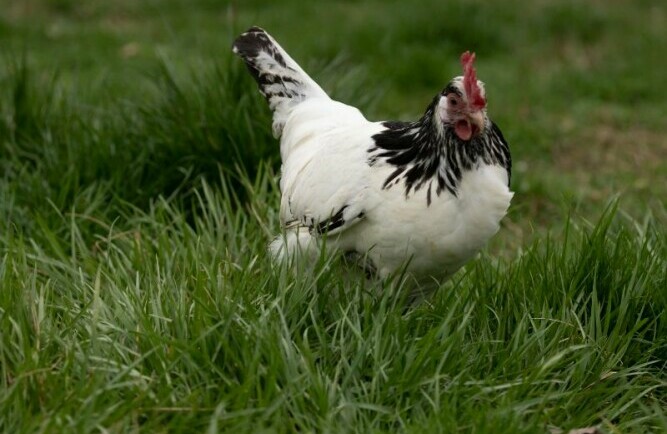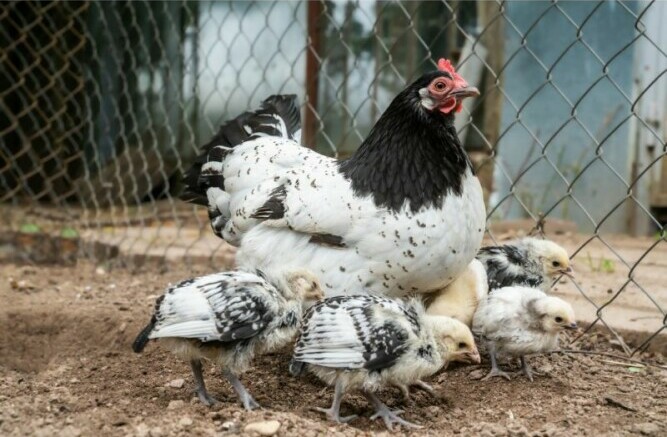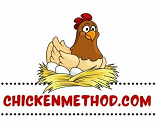Are you ready to add a dash of good looks and a sprinkle of adventure to your backyard flock? Let’s talk about the Lakenvelder chicken, a breed that’s as unique in personality as it is in appearance. Originating from the picturesque landscapes of the Netherlands and Germany, these striking birds are more than just a pretty sight.
With their distinctive black and white plumage and love for exploration, Lakenvelders are like the explorers of chicken-dom. Join us as we find out what makes these independent and lively birds an interesting choice for your coop!
Eye-Catching Appearance

Lakenvelders are good-looking chickens. Their unique black-and-white coloring sets them apart from most other chicken breeds.
Picture this: their sleek black head, necks, and tails contrast sharply with their bright white bodies. It’s as if they’re wearing a formal suit all day long!
This striking color pattern isn’t just beautiful; it’s also quite rare, making Lakenvelders a standout choice for anyone looking to add some visual flair to their flock.
Size and Build
When it comes to size, Lakenvelders hit the sweet spot. They’re medium-sized birds, which means they’re just the right size for most backyard setups.
They’re not as large and heavy as some breeds or too small. This medium build allows them to be agile and active.
They can easily navigate through their environment, whether it’s a spacious coop or a backyard.
Their size also makes them less intimidating for younger chicken keepers, making them a good choice for families.
Personality and Behavior
Now, let’s talk about what these chickens are like on the inside.
Lakenvelders are known for their energetic personalities. They’re not the kind to sit still for long; they’re always on the go. You’ll often find them foraging around, meaning they love to peck and search for food independently.
This makes them excellent at controlling pests in your garden. They’re also quite curious and will often be the first to explore new additions to their environment.
However, it’s worth noting that Lakenvelders value their independence.
They’re not typically the type to seek out cuddles or lap time.
While they might not be the most affectionate birds in the coop, their active nature and keen interest in their surroundings make them incredibly interesting to watch.
They can bring a dynamic energy to your flock, making your chicken-keeping experience more lively and entertaining.
Lakenvelder Egg Production
Lakenvelders may not be the champions of egg-laying, but they hold their own with a respectable output.
They consistently lay white or slightly tinted eggs. You can expect a steady flow of eggs throughout the year, but their quantity won’t overwhelm you.
This makes them ideal for families or hobbyists who appreciate a regular supply of fresh eggs without the pressure of managing a very high yield.
A Lakenvelder hen will lay around 150 to 200 eggs per year. This number can vary depending on factors like their diet, environment, and overall health.
Their eggs are of a good size, perfect for your breakfast or baking needs. For those who enjoy the rhythm of daily or near-daily egg collection without the surplus that comes with more prolific layers, Lakenvelders strikes a nice balance.
Are Lakenvelders a Dual-Purpose Chicken?
Lakenvelder chickens are primarily known for their appearance and moderate egg-laying abilities rather than as meat birds.
They are a lightweight breed, and historically, they have not been bred specifically for meat production. Their build is more slender and less meaty compared to typical meat breeds like Cornish Crosses or Broilers.
However, like most chicken breeds, Lakenvelders can be used for meat if desired. Their meat is said to be of good quality, but the yield is less than the more commonly used meat breeds due to their smaller size.
In a backyard or small farm setting, where chickens might be raised for multiple purposes, Lakenvelders could provide a smaller amount of meat in addition to their egg-laying capabilities.
Why Lakenvelders Love Space, Roaming, and Foraging

The Lakenvelder’s love for space is more than just a preference; it’s a part of their nature.
These birds are happiest and healthiest when they have plenty of room to roam and forage. They are excellent foragers, often seen actively searching the ground for insects, seeds, and greens. This keeps them entertained and helps them maintain a healthy diet.
A spacious yard or field is ideal for Lakenvelders.
They enjoy the freedom to move around, which is essential for their physical and mental well-being.
If you have a garden, they can be particularly helpful in controlling pests, although you might need to protect your more delicate plants from their foraging.
Adapting to Your Backyard
Lakenvelders are quite adaptable and can thrive in various climates, from cooler northern temperatures to warmer southern regions. However, their need for space remains constant across these environments. They do best in settings where they can have access to open areas.
When planning to keep Lakenvelders, consider the layout of your outdoor space.
Do you have enough room for them to explore and forage?
Are there safe, enclosed areas where they can roam freely without the risk of predators?
Ensuring that your backyard meets these needs will help your Lakenvelders thrive and bring joy to your flock.
Are They Right for Your Flock? Considering Their Personality
Lakenvelders are known for their independent streak. They often prefer doing their own thing rather than cuddling up or mingling closely with other chickens.
This doesn’t mean they are antisocial or problematic; they just value their personal space. They’re not typically aggressive, but they do march to their own drummer.
When thinking about adding Lakenvelders to your existing flock, it’s important to consider the personalities of your current birds.
Will they be okay with newcomers who might not interact as much? Lakenvelders can coexist peacefully with a variety of other chicken breeds, but they tend to thrive best with other independent breeds.
If your flock is used to very sociable and interactive breeds, introducing Lakenvelders might require careful management and observation to ensure smooth integration.

Here are some notable independent chicken breeds that could reasonably be mingled with Lakenvelders:
- Leghorn: Famous for their prolific egg-laying abilities, Leghorns are also known for their independence. They are active, foraging well independently, and less likely to seek human attention.
- Hamburg: Hamburgs are another breed that values their independence. They are excellent foragers, prefer to roam freely, and are not typically lap chickens.
- Ancona: Anconas are lively and active birds. They are very good at foraging for their own food and tend to be more flighty and less interested in human interaction.
- Araucana: Known for laying blue eggs, Araucanas are also recognized for their independent nature. They are hardy and prefer to have space to explore.
- Welsummer: Welsummers are known for being good foragers and quite self-sufficient. They are friendly but not overly dependent on human interaction.
- Egyptian Fayoumi: This breed is known for being very active and alert. They are excellent foragers and highly independent, often wary of human contact.
- Lakenvelder: As you’re already familiar with, Lakenvelders are independent and active, enjoying a good forage and exploration.
- Rhode Island Red: While they can be friendly, Rhode Island Reds are also known for being hardy and independent, capable of foraging and taking care of themselves quite well.
- Plymouth Rock: While they can be friendly, Plymouth Rocks are also quite independent. They are good foragers and can adapt to a variety of living conditions.
- Australorp: Australorps, known for their egg-laying prowess, can be friendly but also display a degree of independence, especially when foraging.
These breeds are generally more suited to environments where they have ample space to roam and explore. Their independent nature makes them less demanding in terms of needing constant human interaction, which can be ideal for certain backyard chicken keepers.
My Pet Chicken carries many breeds of chickens that you can choose from.
Space and Environment Needs
Space is a crucial factor when considering Lakenvelders.
These chickens are not the best fit for confined spaces or small backyards. They thrive in environments where they can roam freely and explore.
A large, secure area is ideal for them to express their natural behaviors like foraging, roaming, and exploring. This not only keeps them physically healthy but also mentally stimulated.
If you’re planning to bring Lakenvelders home, assess your available space.
Do you have enough room for them to wander without feeling restricted?
Is the area secure from predators yet open enough to satisfy their curiosity and need for exploration?
Also, consider their shelter. While they are hardy, they still need a safe and comfortable coop to retreat to, especially at night.
Lakenvelders might feel cramped and stressed in smaller spaces, which can affect their overall health and egg-laying capabilities.
If your space is limited, you might want to consider breeds that are more adaptable to smaller areas. However, if you have a spacious yard or a farm, Lakenvelders could be a perfect addition, bringing their unique charm and independence to your flock.
And that’s the scoop on the stunning Lakenvelder chickens!
With their eye-catching looks and spirited nature, they’re sure to bring a unique flair to any backyard. Remember, these independent explorers love their space and thrive in environments where they can roam and forage to their heart’s content.
If you’re looking for a breed that combines beauty with a love for adventure and has the space to accommodate their exploratory needs, Lakenvelders could be the perfect new addition to your flock.
Thank you very much for reading. If you want to share any comments or stories or just say hello, leave a message below. What you share might be that thing that another reader wants to know about.
Dave
Chickenmethod.com
